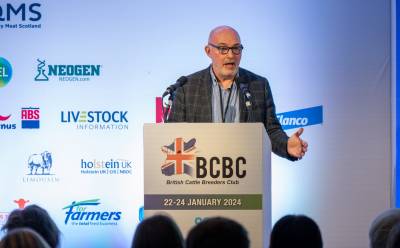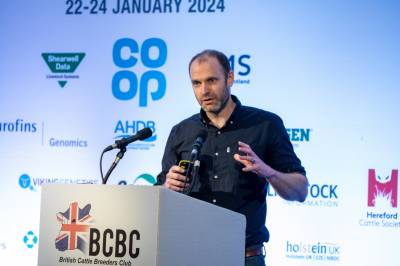

Genetics holds the key to lowering farm emissions and improving farm profits.
This was the message from Dairy speakers at the British Cattle Breeders conference (24 January) at Telford.
Mark Smith, EMEA Beef Director at Genus ABS, said: “Sustainability starts with genetics. It’s permanent and cumulative - it carries on generation after generation.”
Selecting ‘greener genetics’
Mr Smith spoke about Genus’ NuERA dairy beef breeding programme and how it has used beef progeny data alongside feed efficiency data to create a genomic index to demonstrate the profitability of sires within a beef-dairy system.
He said the difference between the best and baseline sires equated to £180 and the most profitable ones also emitted 17% less Greenhouse Gas (GHG) emissions.
VikingGenetics has also been undertaking feed efficiency testing as part of its breeding programme using state-of-the-art 3D cameras.
Trials have revealed big differences in feed intake – more than 1,000kg – between cows giving the same amount of milk (with data corrected for lactation and cow size).
Søren Borchersen from VikingGenetics said data from Denmark shows there is a clear correlation between feed intake and methane production, adding: “If we can lower intakes and hold milk, we should be able to lower methane.”
Dairy farmer Rory Christie, from Dourie Farming Co Ltd in South-West Scotland, demonstrated how a breeding programme could be replicated at farm level.
Led by geneticist Mike Coffey from SRUC, Mr Christie and three other spring calvers have helped create the first crossbreeding genomic index as part of the Fast Breeders Project.
Since 2018 the farmers have genotyped nearly 9,000 animals. The index encompasses milk fat, protein, somatic cell count, and more recently maintenance and fertility.
All three traits (milk fat, protein, and SCC) have improved at Dourie Farming while concentrate use has been lowered.
Improving soil health
Another spring calver, Wil Armitage, said genetics was a key part of a healthy business alongside good cow and soil health, people and profit.
He said: “Dead soils produce empty calories with very little mineral content which challenges our stocks’ immune systems.”
He revealed the steps they were taking to maintain good soil health, including growing a diversity of crops and avoiding bare soils.
Recent audits show one of his farms is producing 0.74kg of carbon/litre of milk after sequestration.
Professor Elizabeth Magowan, Director of Sustainable Agri-Food Sciences Division in the Agri-Food and Biosciences Institute, Northern Ireland, encouraged other farmers to carry out carbon audits and take steps to reduce gross emissions.
She said: “The magnitude of change expected in the next 30 years [to meet targets] is stark. It’s a real wake-up call for us to understand where the agricultural sector needs to be.”
The real value of red meat and dairy
Meanwhile, Professor Alice Stanton, from the Royal College of Surgeons in Ireland, highlighted the vital role red meat and dairy played in human health, revealing that 18 out of 20 of the top sources of commonly lacking nutrients came from animal-sourced foods.
She said two or more full-fat servings of dairy per day is associated with a 25% reduction in colorectal cancer and a 60% reduction in obesity.
Many publications recommending considerable reductions in animal-sourced foods, such as the EAT-Lancet report, had not considered the latest evidence on recommended nutrient intake, she said, and called for better peer-review of academic papers.
New and old ways to reduce farm emissions
Delegates also heard how applying old and new methods could drive farm efficiency and lower emissions.
Tim Geraghty, Veterinary Centre Manager at SRUC, explained how existing cattle tracing data could be used to identify ‘wasted days.’
He said monetary values and carbon emissions could then be calculated for this waste against an optimal model.
A pilot study of cattle movement database in England and Scotland from 2015 to 2020 revealed there were 550m ‘waste days’ costing £860m and producing 3.1m t/CO2.
This was largely caused by poor growth and fertility and early death. Improving these three areas would be the most cost-effective carbon reduction strategy, he added.
Then Robert Morrison, Head of Dairy at Agri-Epi Centre, showcased some of the latest innovations the Agri-tech centres were testing.
One of these was the on-farm slurry treatment system H2OPE which separates dairy slurry producing clean water and a fertiliser pellet that drastically reduces volumes.
BCBC Chairman, Ben Harman, said: “The technology that is just around the corner is hugely exciting.
“But, as we learned, there is plenty we can already be doing – efficient use of natural resources and strong data-driven decision making is the path to sustainable and profitable production.”